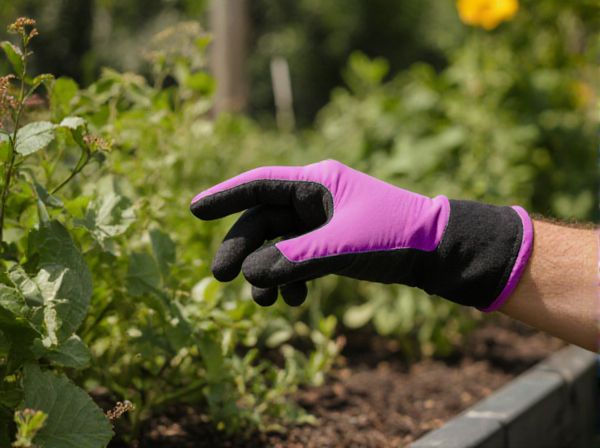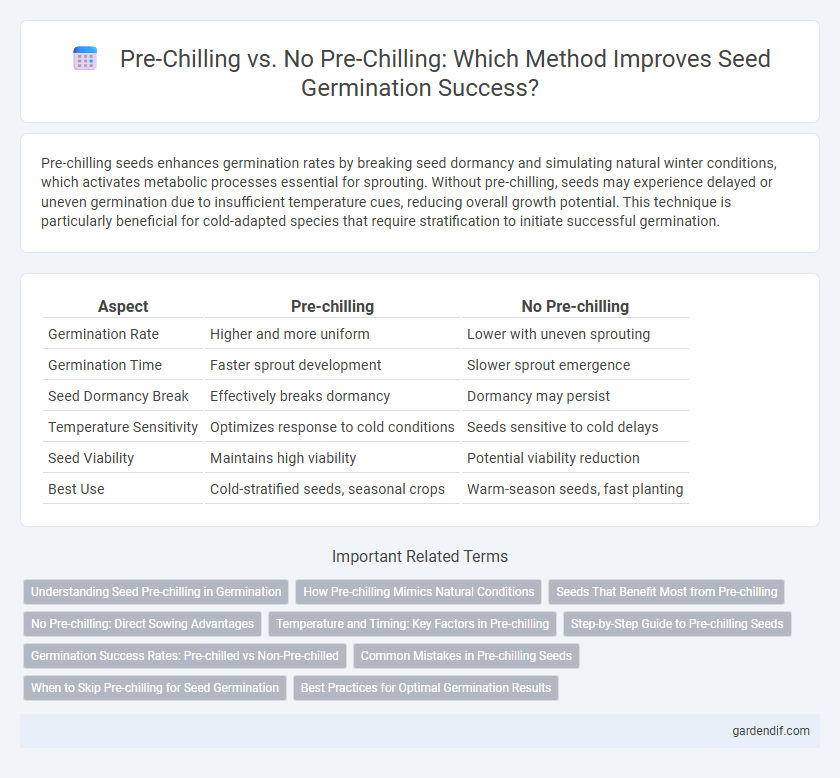
Pre-chilling vs No Pre-chilling Illustration
Pre-chilling seeds enhances germination rates by breaking seed dormancy and simulating natural winter conditions, which activates metabolic processes essential for sprouting. Without pre-chilling, seeds may experience delayed or uneven germination due to insufficient temperature cues, reducing overall growth potential. This technique is particularly beneficial for cold-adapted species that require stratification to initiate successful germination.
Table of Comparison
| Aspect | Pre-chilling | No Pre-chilling |
|---|---|---|
| Germination Rate | Higher and more uniform | Lower with uneven sprouting |
| Germination Time | Faster sprout development | Slower sprout emergence |
| Seed Dormancy Break | Effectively breaks dormancy | Dormancy may persist |
| Temperature Sensitivity | Optimizes response to cold conditions | Seeds sensitive to cold delays |
| Seed Viability | Maintains high viability | Potential viability reduction |
| Best Use | Cold-stratified seeds, seasonal crops | Warm-season seeds, fast planting |
Understanding Seed Pre-chilling in Germination
Seed pre-chilling, or cold stratification, significantly enhances germination rates by simulating natural winter conditions that break seed dormancy. Pre-chilled seeds exhibit faster and more uniform sprouting compared to non-pre-chilled seeds, which often face delayed or incomplete germination. This technique is crucial for species requiring low-temperature exposure to activate metabolic processes essential for seedling development.
How Pre-chilling Mimics Natural Conditions
Pre-chilling seeds replicates natural winter conditions by exposing seeds to cold temperatures, which break dormancy and promote uniform germination. This stratification process activates enzymatic responses crucial for seed metabolism and growth. In contrast, seeds without pre-chilling often exhibit delayed or inconsistent germination due to remaining in a dormant state.
Seeds That Benefit Most from Pre-chilling
Seeds of temperate-climate plants such as carrots, lettuce, and spinach benefit most from pre-chilling, which helps break seed dormancy and improves germination rates. Cold stratification mimics natural winter conditions, promoting uniform sprouting by activating enzymes and metabolic processes in these seeds. Seeds without dormancy or those adapted to warm climates often show little to no improvement from pre-chilling treatments.
No Pre-chilling: Direct Sowing Advantages
No pre-chilling in direct sowing accelerates germination by exposing seeds to natural soil temperatures immediately, reducing labor and time costs associated with seed treatment. This method minimizes the risk of seed damage or fungal infections that can occur during chilling phases, promoting healthier seedling development. Direct sowing without pre-chilling also enables better synchronization with seasonal soil moisture levels, enhancing crop establishment and yield potential.
Temperature and Timing: Key Factors in Pre-chilling
Pre-chilling at optimal temperatures between 1degC and 5degC for specific durations, typically 2 to 4 weeks, significantly enhances seed germination rates by breaking dormancy. Without pre-chilling, seeds often require higher temperatures and longer germination periods, leading to inconsistent sprouting. Precise control of temperature and timing during pre-chilling activates metabolic processes essential for uniform and rapid germination.
Step-by-Step Guide to Pre-chilling Seeds
Pre-chilling seeds involves placing them in a moist medium such as damp paper towels or soil at a controlled temperature between 1-5degC for a period of 2 to 8 weeks, depending on the species. This stratification process breaks seed dormancy by simulating winter conditions, enhancing germination rates and uniformity for cold-hardy plants like apples, cherries, and certain perennials. Seeds without pre-chilling often exhibit delayed or inconsistent germination, reducing overall growth success in temperate climate gardening.
Germination Success Rates: Pre-chilled vs Non-Pre-chilled
Pre-chilling seeds significantly enhances germination success rates by breaking seed dormancy and simulating natural winter conditions, leading to faster and more uniform sprouting. Non-pre-chilled seeds often exhibit lower germination percentages and extended lag times due to dormancy retention. Studies indicate pre-chilling can improve germination success by up to 30% compared to seeds without cold stratification.
Common Mistakes in Pre-chilling Seeds
Pre-chilling seeds improperly often leads to reduced germination rates due to exposure to inconsistent temperatures or excessive moisture, which can cause seed rot or dormancy disruption. Many gardeners mistakenly pre-chill seeds that do not require cold stratification, wasting time and resources without improving germination. To avoid these errors, it is crucial to identify seed-specific chilling requirements and maintain precise temperature and moisture levels during the pre-chilling period.
When to Skip Pre-chilling for Seed Germination
Skip pre-chilling for seed germination when working with warm-season crops like beans, corn, and cucumbers, as their seeds typically germinate best at higher soil temperatures without cold stratification. Seeds of tropical or subtropical plants also do not require pre-chilling and may even be inhibited by exposure to cold. Avoid pre-chilling if the seed packet specifically advises direct sowing or immediate planting to ensure optimal germination rates.
Best Practices for Optimal Germination Results
Pre-chilling seeds at 4degC for 2-4 weeks breaks dormancy by simulating winter conditions, significantly enhancing germination rates and uniformity in species like lettuce and tomatoes. Seeds without pre-chilling often exhibit slower germination and lower sprouting percentages, especially in temperate crops sensitive to cold stratification. Implementing pre-chilling as a best practice optimizes seedling vigor and accelerates emergence, ensuring consistent crop establishment.
Pre-chilling vs No Pre-chilling Infographic

 gardendif.com
gardendif.com